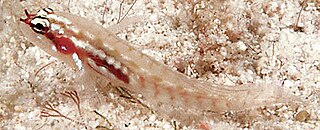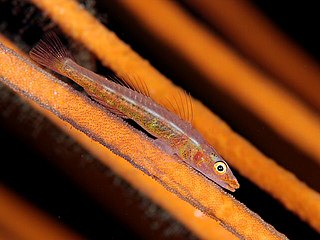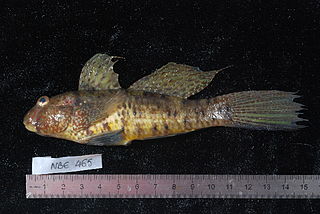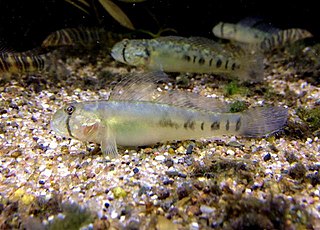
Eviota sigillata, commonly called seven-figure pygmy goby or adorned dwarfgoby, is a species of marine fish in the family Gobiidae. They are widespread throughout the tropical waters of the Indo-West Pacific area, from the Seychelles to the Micronesia.

Glossogobius giuris, the tank goby, is a species of goby native to fresh, marine and brackish waters from the Red Sea and East Africa through South Asia and the Indian Ocean to China, Australia and the islands of the Pacific Ocean. This species can also be found in the aquarium trade. It is also known as the bar-eyed goby, flat-headed goby and the Gangetic tank goby.

Valenciennea puellaris, the Orange-spotted sleeper-goby, Orange-dashed goby, or Maiden goby,Diamond Watchman goby, is a species of goby native to the Indian Ocean and the western Pacific Ocean. It inhabits lagoons and outer reefs where it occurs on sandy substrates with larger pieces of rubble to burrow under. It can reach a length of 20 centimetres (7.9 in) SL. It is a prevalent fish in the aquarium hobby. Its main diet is composed of zoo plankton and dead fish or insects.
Schindleria praematura, Schindler's fish is a species of neotenic goby which was formerly placed in the monogeneric family Schindleriidae but which is currently classified within the Gobiidae. It is associated with reefs and has an Indo-Pacific distribution from South Africa and Madagascar to Hawaii and the sea mounts of the South Pacific. The generic name and the common name honour the German zoologist Otto Schindler (1906–1959) who described the species.

Oxyurichthys microlepis, the maned goby, is a species of goby native to tropical marine and brackish waters along the coasts of the Indian Ocean from Africa to the western Pacific Ocean where it occurs in estuaries and inshore waters to depths of about 75 metres (246 ft). It occurs in the Mekong Delta and is suspected to use the tidal flow up the river to reach as far inland as Cambodia. This species can reach a length of 13.5 centimetres (5.3 in) TL. It is of minor importance to local commercial fisheries and can also be found in the aquarium trade.

Priolepis semidoliata, the half-barred goby, is a species of goby native to the Indo-Pacific region.

Panulirus ornatus is a large edible spiny lobster with 11 larval stages that has been successfully bred in captivity.

Valenciennea helsdingenii is a species of goby from the Indo-Pacific. It is commonly known as the twostripe goby, black-lined sleeper goby, or railway sleeper goby. It can grow up to a length of 25 cm (9.8 in) and is distinguishable by two prominent orange to black lines running longitudinally through its body.

Istigobius is a genus of gobies found in fresh, brackish and marine waters of the regions along the coasts of the Indian and western Pacific oceans.

The wolfsnout goby, also known as the dognsout goby or cup-sponge goby, is a species of goby native to the Indian Ocean and the western Pacific Ocean. This species lives on large fan-shaped or floppy sponges, particularly Phyllospongia foliascens and Phyllospongia papyracea, growing on reefs at depths down to 15 metres (49 ft). This species grows to a length of 3.5 centimetres (1.4 in) SL. This species is the only known member of its genus. It spans benthically and is a solitary species.

The largetooth goby, also known as Wilbur's goby, is a species of ray-finned fish from the family Gobiidae which is native to the Indo-Pacific from the Seychelles to Micronesia. Its known range has been extended to the Red Sea as specimens were photographed at one site and collected at another site off Egypt. This species lives in sheltered marine waters at depths of from 0 to 20 metres preferring areas with sandy substrates. This species grows to a length of 6.5 centimetres (2.6 in) SL. This species is the only known member of its genus. This species is not obviously sexually dimorphic and it has a background colour of pale brown to greenish-brown and a pale ventral side. The body is marked with brown and white spots, pairs of larger brown spots create a mid-lateral row along its flanks and there is a dark spot on the caudal fin peduncle. It has a brown blotch on the cheek and a series of short brown bars along its back. The largetooth goby is a solitary fish which is found in coastal bays, lagoons and estuaries over fine sandy substrates close to the margins of reefs or silt beds in the vicinity of sheltered and often turbid coastal reefs. It is most frequently collected from shallow waters to 7 metres (23 ft), around coral reefs but off southern Japan, the largetooth goby occurs at the bottom of sandy bays. The specific name honours the American physician, Ray Lyman Wilbur (1875–1949) who was president of Stanford University from 1916–1943, as well as being the United States Secretary of the Interior from 1929–1933. Wilbur helped the author, Herre, get to Palau, the type locality of this species.

Bryaninops amplus, known commonly as the large whip goby or white-line seawhip goby, is a species of marine fish in the family Gobiidae.

Bryaninops erythrops, known commonly as the translucent coral goby or Erythrops goby , is a species of marine fish in the family Gobiidae.

Drombus globiceps is one of ten species of goby in the genus Drombus. It is found in the western Indo-Pacific. Its common names include Kranji drombus and bighead goby. It is a tropical fish and has been recorded from the Ganges Delta and Chilika Lake of India, the Bay of Bengal, Thailand, Singapore, Indonesia, Papua New Guinea, and the Northern Territory and northern Queensland of Australia. It lives in both marine and fresh water environments. It is considered that D. globiceps is possibly a synonym of Drombus ocyurus. Its threats to human is least concerned.

Amblygobius sphynx or the Sphinx goby is a species of goby found in brackish and salt water in the Indo-West Pacific region.

Oligolepis acutipennis, the Sharptail goby, is a species of goby native to marine, freshwater and brackish waters along the coasts of Indo-West Pacific region. This species can reach a length of 12 centimetres (4.7 in) TL.

The Malabar goby, Stenogobius gymnopomus is a species of goby endemic to the Indo-Pacific regional countries such as India, Somalia, Indonesia, Andaman Islands. where it can be found in marine, brackish and fresh waters. The habitats include coastal waters, estuaries and tidal zone of rivers. This species can reach a length of 15.0 centimetres (5.9 in) SL. It feeds mainly on cladocerans, as well as fish eggs and scales. This species is a batch spawner which has a prolonged spawning season, extending from August to December in Kerala. The female's fecundity was between 46,323 and 61,291 eggs while the sex ratios favours males in local populations.

The dusky frillgoby, also known as the brown frillfin, is a species of goby which is found in the Indo-Pacific region from the South Africa north to the Red Sea and east as far as Tonga, south to Australia and north to Japan. It is a mainly coastal speciesbut it has an amphidromous life cycle and it occurs in estuaries and will move into in freshwater streams. In estuarine areas it is found mainly in the creeks preferring environments with sand and rubble, soft coral and open reefs. It feeds on detritus, as well as feeding on crustaceans, fish and algae and it is a benthic spawner. The maximum total length is 12 centimetres (4.7 in).

Ctenogobiops tangaroai, the silver-spotted shrimp-goby, is a species of bony fish of the family Gobiidae, native to the reefs which is widespread in the Indo-West Pacific, from the Red Sea and Western Indian Ocean through northern Australia and Taiwan, southern Japan and Fiji. It occurs in fine-grained sand patches at depths of from 4 to 40 metres where it is commensal with alpheid shrimps, with a fish and shrimp sharing a burrow. This species can reach a length of 6 centimetres (2.4 in) TL. It can also be found in the aquarium trade. It is pale in colour marked with four rows of brown spots or dashes along its flanks, three diagonal rows of short, dark stripes on the posterior of its head with larger dark spots on the lower flanks which are frequently surrounded by smaller blue spots and there is a small white stripe above the pectoral fin base with a longer white streak on the pectoral fin. It is the type species of the genus Ctenogobiops.

Pleurosicya mossambica, also known as the toothy goby or the Mozambique ghost goby, is a small species of goby native to the tropical Indo-West Pacific region. It was first described by South African ichthyologist J.L.B. Smith in 1959. Like many other gobies, it forms commensal relationships with several other marine invertebrates, including soft corals and sponges.




















